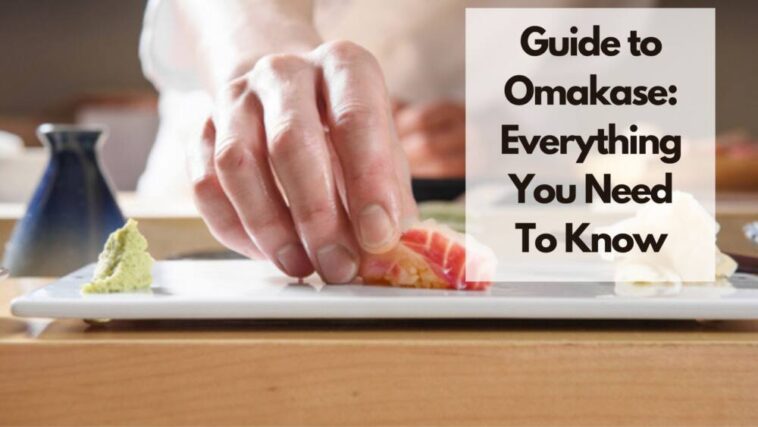Wondering what omakase is? Well, here’s a guide on what is omakase and how the Japanese use Omakase in their cuisine. Check it out!
Japan is full of tradition and culture that are nothing like traditions you may have come across. These traditions and the culture are given much importance and haven’t changed much over the years. This extends to food and dining etiquette as well.
If you have ever had the chance of dining at a traditional Japanese restaurant, you would agree that the experience is not what you would expect in a regular restaurant. Right from the way food is served to the dining etiquette that is considered polite, Japanese dining has its own unique style and charm.
Personally, omakase is my favourite and has been by far one of my most favourite experiences in Japan.

Omakase can be experienced at Japanese restaurants outside of the country as well. However, not all restaurants inside or outside Japan offer their customers the experience.
- Related: Best Types Of Sushi To Try When Visiting Japan
- Related: Must-try Japanese Street Food
- Related: Why Japanese Eat Raw Fish
- Related: Japanese Food to try
Page Contents
What is Omakase?
So let us begin by understanding what omakase is. Omakase is a form of Japanese dining that translates to letting someone else decide what is best. When you order for Omakase in a Japanese restaurant, the head chef decides your meal for you.
Omakase gives diners a chance to interact intimately with the sushi chef as well as the food. Let’s be honest, being able to experience all the textures of your food and being a part of the preparation process somehow enhances the taste of food.
Omakase originated back in the 1990s in sushi restaurants in Japan. Back then, sushi was a pricey affair and was popular among people who knew fish well and enjoed the skillfulness of a sushi chef.
Then Japan’s economic bubble walked in and brought many new people to sushi shops. These people were not as familiar with the sushi culture but still made their way to high end sushi shops. Since they didn’t know what to order, it was often left to the chef to serve what he thought was best. This was how omakase became popular.
The first course is served based on the fresh produce thatis available for that day. The rest of the courses are prepared according to the diner’s reaction to the previous course as perceived by the chef.
Unlike traditional restaurants, when your order omakase you get to sit in front of the head chef. The head chef will explain the dish and what goes into preparing it so that you are an active part of the experience.
This is an intimate experience and if you are lucky, the chef will share little glimpses into his life. You will be introduced to new ingredients, styles of cooking, maybe even the chef’s hobbies and passion.
Now I don’t know about you, but I love getting to know people over a good plate of food. There’s just something so raw and honest about the whole interaction.
My experience ordering omakase
The first time I tried omakase was during one of my initial visits to Japan. I was intrigued to find out more about this unique practice but also apprehensive. What if I didn’t like what the chef picked out for me? How would the chef know what I like?
But I was pleasantly surprised when I got to taste some of the finest sushi that day. My taste buds were tingling with satisfaction by the end of my meal.
The head chef, who served me, took his time explaining each ingredient, its origin and purpose. I was taken aback by how skillfully he moved his knife and plated my food. He kept the conversation flowing with small excerpts from is life, and included stories from his travels and experience with food around the world.
All the apprehension and pressure vanished when the chef did his best to make me comfortable and kept checking in to see if I liked what was being served.
There was no rush. It was an experience of a lifetime. I don’t think I had ever viewed dining like this before.
Before this, sushi was well, just sushi. But after getting involved in the preparation and understanding each ingredient, I developed a new appreciation for not just sushi, but all food.
How is omakase different?
A lot of times omakase is mixed up with kaiseki. They both involve Japanese cuisine being experimented with and there is much focus on presentation, but they are different experiences.
Kaiseki is fine dining at its best with a pre-fixed menu. It is a multi course meal that usually comprises 9 to 15 small dishes.
Omakase, on the other hand, involves a more intimate experience with the chef. It doesn’t have a fixed menu. The chef often improvises and the meal progresses based on the diner’s reaction.
How much does omakase cost?
While omakase is one of my favourite things to try in restaurants and I highly recommend it to anyone visiting a Japanese restaurant, it can be heavy on the pocket.
Omakase involves an intimate interaction with the chef and the finest ingredients go into your meal. The high standard of the meal chosen just for you can work out to be quite expensive when compared to other meals in a Japanese restaurant.
While costs vary from place to place, on an average, omakase can cost around $100 to $300 for a single person.
Recently, there have been a few restaurants that have begun offering omakase at prices as low as $50 and lower. However, they don’t provide the authentic omakase experience and are quite rare.
Another thing to remember is that your bill will mostly be a non itemized bill presented at the end of your omakase experience. This could be a gamble since ordering omakase is seen as a request for a wonderful meal.
While expensive, Omakase is worth every penny. You can rest assured that you are going to be served food of high standards, made with quality ingredients.
Besides this, each party of diners is given a head chef all to themselves and therefore the restaurant cannot accommodate too many. The personalized experience is usually in high demand and so diners are advised to book well in advance.
What are the popular omakase dishes?
Omakase usually serves a variety of different sushi. However, there are many other dishes and styles of cooking that can be seen in omakase.
Since a lot of fresh ingredients are used in omakase, you can expect local produce from the local markets to be included in your meal.
Besides sushi, some popular dishes served in omakase are Hassun, Sashimi, oysters, beef tenderloin, nigiri, and Dashi.
It is polite to leave it up to the chef while ordering omakase. Don’t set conditions unless you have to share food allergies and dislikes beforehand.
Tips to remember while ordering omakase
Omakase is a traditional Japanese dining experience. If you are not familiar with the Japanese culture, you must know that the Japanese people are big on respect and manners.
Here are a few tips to help you enjoy your omakase experience.
- Since omakase means that the chef decides what you eat, it is polite to not ask for alterations in the food being served, unless in some cases like food allergies.
- Greet your chef politely when you first meet them. Traditionally, you can greet them with “itadakimasu”, pronounced as “ee-tah-dah-kee-mah-su”.
- When you’re done with your meal, thank your chef with “gochisosama deshita”, pronounced as “go-chee-sou-sa-ma-deh-shee-tah”.
- Be polite while interacting with the chef, but avoid asking personal questions.
- Always ask before taking pictures.
- When sushi or other similar foods are served, try to eat it in a single bite.
What is Omakase: FAQs
What is so special about omakase?
Omakase is a form of fine Japanese dining. When you order omakase, it means that you are leaving it up to the chef to decide your meal for you. Diners are involved in the preparation of the food with the head chef explaining what goes into the dish and sharing stories.
How much does omakase cost?
Omakase can be expensive and authentic omakase can cost anywhere between $100 to $300 and sometimes even more. In Japan, the cost for omakase usually begins at around 10,000 Japanese Yen. This does not include wine or sake.
How long is an omakase dinner?
As compared to usual dinners, omakase is much longer. It involves a lot of preparation and may include many small meals. It can take up to two hours.
Is omakase always sushi?
Omakase usually serves sushi, but there are non-sushi items like salads, tempura and soups that are also included.
What is the difference between omakase and kaiseki?
The main difference is that kaiseki comes with a pre fixed menu for each course. Whereas in omakase, the chef can improvise and alter the next course to suit the diner’s preferences.
Do you share omakase?
Omakase portions are usually prepared to serve one person and so cannot be shared. The sushi is best eaten in one bite as each ingredient is put in a ratio that makes it perfect for a single bite.
Also Read:





